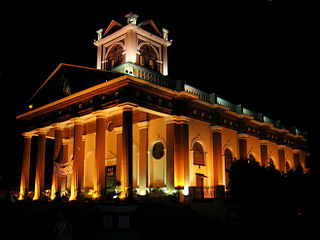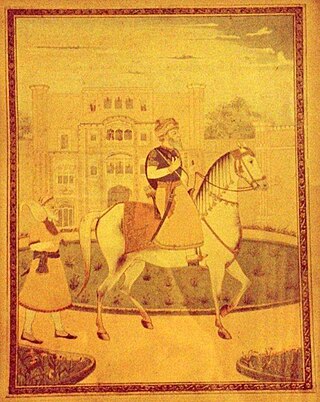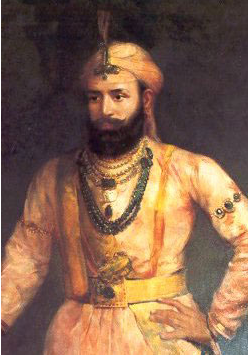
Kapurthala is a city in Punjab state of India. It is the administrative headquarters of Kapurthala District. It was the capital of the Kapurthala State, a princely state in British India. The aesthetic mix of the city with its prominent buildings based on French and Indo-Saracenic architecture self-narrate its princely past. It is also known as city of Palaces & Gardens. According to the 2011 census, Kapurthala is the least populated city in India.

The Sikh Empire was a regional power based in the Punjab region of the Indian subcontinent. It existed from 1799, when Maharaja Ranjit Singh captured Lahore, to 1849, when it was defeated and conquered by the British East India Company in the Second Anglo-Sikh War. It was forged on the foundations of the Khalsa from a collection of autonomous misls. At its peak in the 19th century, the empire extended from Gilgit and Tibet in the north to the deserts of Sindh in the south and from the Khyber Pass in the west to the Sutlej in the east as far as Oudh. It was divided into four provinces: Lahore, which became the Sikh capital; Multan; Peshawar; and Kashmir from 1799 to 1849. Religiously diverse, with an estimated population of 12 million in 1831, it was the last major region of the Indian subcontinent to be annexed by the British Empire.
Guru Nanak founded the Sikh religion in the Punjab region of the northern part of the Indian subcontinent in the 15th century and opposed many traditional practices like fasting, janeu, idolatry, caste system, ascetism, azan, economic materialism, and gender discrimination.

Jassa Singh Ramgarhia (1723–1803) was a prominent Sikh leader during the period of the Sikh Confederacy. He was the founder of the Ramgarhia Misl.

Sultan-ul-Qaum Sardar Jassa Singh Ahluwalia was a Sikh leader during the period of the Sikh Confederacy, being the Supreme Leader of the Dal Khalsa. He was also Misldar of the Ahluwalia Misl. This period was an interlude, lasting roughly from the time of the death of Banda Bahadur in 1716 to the founding of the Sikh Empire in 1801. He founded the Kapurthala State in 1772.

Baghel Singh was a Military general in the Punjab region in the northern part of the Indian subcontinent in the 18th century. He rose to prominence in the area around Sutlej and Yamuna. He joined the Singh Krora Misl, one of the misls during Sikh Confederacy. In 1765, Singh became the leader of the misl.

Kanwar Sri Bikrama Singh Bahadur was a 19th-century Sikh leader.
Raja Sir Harnam Singh Ahluwalia , KCIE was a member of the Kapurthala royal family in the direct line founded by Jassa Singh Ahluwalia.

Kapurthala State, was a kingdom and later Princely state of the Punjab Province of India. Ruled by Ahluwalia Sikh rulers, spread across 510 square miles (1,300 km2). According to the 1901 census the state had a population of 314,341 and contained two towns and 167 villages. In 1930, Kapurthala became part of the Punjab States Agency and acceded to the Union of India in 1947.
The NJSA Government College or Nawab Jassa Singh Ahluwalia Government College, also known as the Randhir College, is a college situated in Kapurthala, in Punjab. Established in 1856 by Maharaja Randir Singh in Kapurthala State as Sanskrit vidyalya, it has many historical buildings used for public services such as district courts, education, and health services. It was first college to be affiliated with the University of Calcutta. In 1857 Nawab Jassa Singh Ahluwalia Government College, and remained so 1882, when University of the Punjab was set up in Lahore. It is named after Nawab Jassa Singh Ahluwalia, the founder of Kapurthala State. It is now affiliated with Guru Nanak Dev University, Amritsar.

The Kalwar,KalalorKalar are an Indian caste historically found in Uttar Pradesh, Rajasthan, Punjab, Haryana, Jammu & Kashmir and other parts of north and central India. The caste is traditionally associated with the distillation and selling of liquor, but around the start of the 20th century assorted Kalwar caste organisations sought to leave that trade and redefine their community through Sanskritisation process.

Ramgarhia Misl was a sovereign state (misl) in the Sikh Confederacy of Punjab region in present-day India and Pakistan. The misl's name is derived from Qila Ramgarh, a place located in Ramsar, near Amritsar, which was fortified and redesigned by Ramgarhia Misl chief Jassa Singh Ramgarhia. The Ramgarhia Misl was one of the twelve major Sikh misls, and held land near Amritsar.
Badhauli is a village of Naraingarh tehsil of Ambala district of Haryana.The village is situated on the bank of river Begna. According to the 2011 Census, there were 747 families residing in the village and its population was 4442, of whom 2346 were males and 2096 were females. Its most famous families are the banglewale, Chathalle and Kuapur families. The village belongs to powerful people.

Gurbaksh Singh Kanhaiya was the eldest son and heir of Jai Singh Kanhaiya, the chief of the Kanhaiya Misl. He was the father of Maharani Mehtab Kaur and thus, the father-in-law of Maharaja Ranjit Singh, the founder of the Sikh Empire.

The Battle of Delhi was fought between Khalsa Sikhs and the Mughal Empire in 1783.
Ahluwalia is an Indian caste native to the Punjab region.

Fateh Singh Ahluvalia was the ruler of the Kapurthala State between 10 July 1801 – 20 October 1837.


















